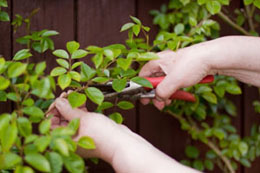Pruning helps trees to grow and flower better. This article attempts to answer a common garden query - 'how to prune climbing roses'? These plants are as popular as their bushy twins. Pruning them in the correct way will ensure that you get a bountiful growth of the plants and have a great garden.

There are many variety of roses, that one can grow in a garden to beautify it. The climbing rose is one such variety, that is trained on a trellis, wall, or clambered into a tree, and when in full bloom, is one of the most delightful sights in the garden. Pruning this plant requires attention so that its healthy growth is maintained and to increase the number of new sprouts. Most of them need seasonal and light pruning, to expose them to light and air.
One of the most essential requirements of pruning is having good gardening tools; sharp pairs of shears (garden scissors), in different sizes. A jagged end will damage the delicate stems, and bud growth. Climbing roses are not self-training, they need to be trained onto a garden trellis or a horizontal support fencing. If left to its own design, they become a tangled mess of branches with very few and unhealthy flowers. Pruning should be done any time between late autumn and late winter, as by then, the flowering season is over, and the climber has shed its leaves. It is easier to shear them when the plants are bare, as they allow a better idea of its trailing route.
Pruning Young Climbing Rose Plants
Young climbers need formative training and pruning to establish themselves. Young climbing roses that are under 3 years, should not be pruned frequently, as it is important for the main veins to grow strong and establish themselves. A couple of main strong vines should be trained out horizontally, to ensure that the shoots do not cross each other. The sprouts (shoots) coming from these vines are the flower producers. To facilitate speedy growth on the main branches (vines), tip-prune them till the first strong bud, to encourage new lateral shoots. Around the same time, remove all dead, diseased or weak growth, and dead flower heads to encourage further flowering. One can also carry out this activity just before the flowering season starts. However, this is done to clear the plants of any overgrowth, or entanglements. Do not crop close to the flowering bud sprouts. A young climber should be trimmed only to encourage growth, until well established.
Pruning Established Plants
Pruning is easier for established roses than young climbers. As their formative training is done, pruning is only done to further bushy and large flower growths. Once the flowering season is over, and the plant is bare, limit the rose vines (major ones) to about four or six, and spread them out on all sides. Preferably keep the younger green ones, and remove the excess vines. Cut back the tips of these vines by a couple of inches. Unlike other roses, only the tips have to be trimmed for climbers, as it is unhealthy for the plant to have its main stems (down stems) severely cut back, and pruning back the long stems will alter the look and training of the climber. However, dead stumps at the base of the plant can encourage rot, so that also needs to be cut away. One can lightly prune the main stems, by cutting back the side shoots about 2-3 inches, only if they have outgrown their space.
Pruning will also depend on the two types; once flowering and repeat flowering climbers. Once flowering roses should be pruned immediately after the flowering season is over. As they mostly flower on the old wood, trim just about a quarter of the wood stems. Trim repeat flowering climbers during its inactive period. Constantly keep cutting dead flower heads to encourage speedy re-flowering. Do this either in late winter or early spring, cut about one-third of the old wood veins, and trim the remaining to control its growth and shape.
While pruning will help to boost the growth, aftercare also plays a vital role in its establishment. Clear all pruned and rotted stems, leaves, and flowers from around the climber base and dispose it. This will help control the spread of plant diseases like mildew, black spot, etc. Spread a rose fertilizer over the soil and mulch them with layer of garden compost to encourage growth. Pruning will also encourage the growth of healthier stems and attractive large-sized roses.






 There are many variety of roses, that one can grow in a garden to beautify it. The climbing rose is one such variety, that is trained on a trellis, wall, or clambered into a tree, and when in full bloom, is one of the most delightful sights in the garden. Pruning this plant requires attention so that its healthy growth is maintained and to increase the number of new sprouts. Most of them need seasonal and light pruning, to expose them to light and air.
There are many variety of roses, that one can grow in a garden to beautify it. The climbing rose is one such variety, that is trained on a trellis, wall, or clambered into a tree, and when in full bloom, is one of the most delightful sights in the garden. Pruning this plant requires attention so that its healthy growth is maintained and to increase the number of new sprouts. Most of them need seasonal and light pruning, to expose them to light and air.